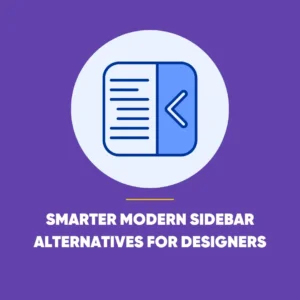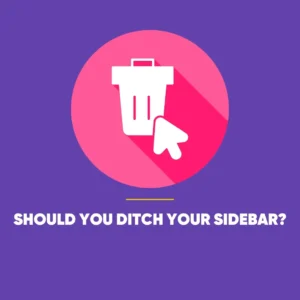Modern Sidebar Alternatives in Web Design
Modern sidebar alternatives are redefining web design with cleaner layouts and smoother, mobile-friendly user experiences. Once filled with widgets, tag clouds, and visitor counters, it now sits awkwardly alongside sleek, mobile-optimised layouts. The question many designers are asking in 2025 is simple: does the sidebar still have a place in modern web design?
The Rise and Fall of the Sidebar
In the early days of the web, sidebars were essential. They hosted navigation menus, recent posts, and shiny “Subscribe via RSS” buttons. They offered convenience and order at a time when websites were still learning to organise information.
However, as design evolved towards cleaner layouts and mobile-first experiences, the sidebar started to lose its purpose. Today, most visitors simply scroll through content without ever glancing at that narrow column to the side. Studies have confirmed this – nearly 80% of users ignore sidebar elements entirely, preferring to focus on the main content area.
In mobile design, the situation is even worse. Sidebars are often hidden, collapsed, or removed altogether, creating two entirely different user experiences. For many designers, maintaining both is no longer worth the effort.
The Legacy Behind Modern Sidebar Alternatives
 If sidebars are so ineffective, why do they still exist? The answer lies partly in habit. Many content management systems – such as WordPress or Drupal – were built with sidebar-friendly templates by default. Over time, designers simply filled those spaces because they were already there.
If sidebars are so ineffective, why do they still exist? The answer lies partly in habit. Many content management systems – such as WordPress or Drupal – were built with sidebar-friendly templates by default. Over time, designers simply filled those spaces because they were already there.
Plugin ecosystems only reinforced this dependency. Advertising widgets, category lists, and comment feeds were all designed to live within that side column. Removing it entirely often means breaking templates, rewriting layouts, or restructuring how plugins function – tasks that require time and effort many teams prefer to avoid.
But clinging to old design conventions is not strategy – it’s stagnation. Modern websites need to serve users, not outdated templates.
The Age of Flow and Minimalism
Today’s digital experiences are guided by movement and rhythm – scrolling, swiping, tapping. Modern users expect seamless flow rather than compartmentalised layouts. In this world, the static sidebar feels awkward and disconnected.
Designers are now focusing on narrative-driven interfaces, where each scroll introduces new layers of interaction. Instead of cramming content into boxes at the edge, designers integrate supporting material within the reading flow itself – inline links, expandable cards, and embedded prompts that appear contextually, not randomly.
The web has moved from segmented zones to fluid storytelling. The sidebar simply doesn’t fit that journey anymore.
When Modern Sidebar Alternatives Still Make Sense
To be fair, there are cases where sidebars still earn their keep. Contextual relevance can be powerful.
For instance, a sidebar might hold a glossary alongside a technical article, or a persistent shopping cart within an e-commerce site. Progress indicators, running commentary, or supporting resources can genuinely enhance the experience when placed thoughtfully.
The issue isn’t the existence of a sidebar – it’s the misuse of it. Too often, sidebars are filled with unrelated clutter: “Follow us” prompts, irrelevant links, or distracting videos. These additions dilute rather than support the main purpose of the page.
When used with intent, the sidebar becomes part of the experience. When not, it becomes digital noise.
Smarter Modern Sidebar Alternatives for Designers
 The most forward-thinking designers of 2025 aren’t mourning the sidebar – they’re reimagining what secondary content can be. Here are a few emerging trends:
The most forward-thinking designers of 2025 aren’t mourning the sidebar – they’re reimagining what secondary content can be. Here are a few emerging trends:
1. Sticky or Floating Elements
Call-to-action buttons or navigation items can stay visible as users scroll, ensuring they’re accessible without disrupting content flow.
2. Inline Enhancements
Instead of pushing related content aside, designers now embed it within the main article – such as expandable sections, inline recommendations, or pull quotes that invite interaction.
3. Adaptive Navigation Bars
Navigation that responds to user behaviour – expanding, collapsing, or morphing as visitors explore – replaces the static sidebar menu entirely.
4. End-of-Content Prompts
Rather than hoping users glance sideways, modern sites offer next steps after the main content – links to related pages, sign-up forms, or reading suggestions appear naturally once attention peaks.
These alternatives feel purposeful and modern, aligning with how people actually consume content in a scroll-driven world.
Accessibility and Performance Considerations
Beyond design, sidebars can create real usability issues. They often confuse screen readers, disrupt tab order, or add unnecessary visual clutter. Some accessibility tools even skip them entirely, reducing the inclusivity of the experience.
From a technical standpoint, sidebars increase layout complexity and page load times – especially when packed with scripts and third-party widgets. On smaller screens, they’re either hidden or pushed to the bottom, where they add little value but still consume resources.
A good design rule applies here: if a piece of content is vital, it shouldn’t live in the sidebar. And if it’s not vital, perhaps it shouldn’t exist at all.
Rethinking Modern Sidebar Alternatives, Not Reducing
Removing the sidebar doesn’t mean stripping away useful information. It’s about placing that information where it makes the most sense. The best designs don’t hide content – they integrate it intuitively.
For example, a blog might weave author bios into the article footer, or an e-commerce site might show related items as part of the product feed. Instead of asking, “Where can we put this?”, designers now ask, “Does this help the user here?”
This mindset shift – towards context-aware, user-first design – is what separates modern experiences from dated layouts.
Should You Ditch Your Sidebar?
 To decide whether your site still needs a sidebar, consider these questions:
To decide whether your site still needs a sidebar, consider these questions:
- Would your website still function if the sidebar disappeared?
- Are users actually engaging with it?
- Does it work properly on mobile devices?
- Does it enhance the user experience, or merely decorate it?
- Do analytics justify its existence?
If you answered “no” to most of these, it might be time for a redesign rather than another quick fix.
The Future: Design Without Baggage
Good design evolves. It questions what came before, keeps what works, and discards what doesn’t. The sidebar once helped users navigate chaotic early websites, but times have changed. Today, clarity, flow, and purpose drive design decisions.
Sidebars are not sacred – they’re optional. And increasingly, they’re obsolete. Removing them isn’t an act of destruction; it’s an act of refinement.
By letting go of this outdated element, designers can focus on what truly matters – content that serves, guides, and engages users wherever they are.
Perhaps it’s not aModern sidebar alternatives are transforming web design, replacing cluttered layouts with cleaner, mobile-friendly and more engaging experiences.bout killing the sidebar at all. It’s about setting it free – and, in the process, freeing web design itself.









